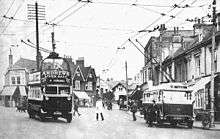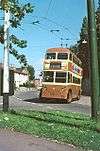Trolleybuses in Hastings
The Hastings trolleybus system once served the town of Hastings, East Sussex, England. Opened on 1 April 1928,[1][2] it gradually replaced the Hastings tramway network, with the first route to be converted that from the Fishmarket to Hollington, East Sussex and the last, the circular route[3]. Tram replacement cost £1,383 per mile,[lower-alpha 1] but increased average speed from 7.5 to over 10 mph and cut costs from 13d to 10d per mile.[4][lower-alpha 2]
| Hastings trolleybus system | |||
|---|---|---|---|
 A pair of Hastings trolleybuses, ca. 1928. | |||
| Operation | |||
| Locale | Hastings, East Sussex, England | ||
| Open | 1 April 1928 | ||
| Close | 31 May 1959 | ||
| Status | Closed | ||
| Routes | 10 | ||
| Operator(s) | Hastings Tramway Company (1928–1935) Maidstone & District Motor Services (1935–1959) | ||
| Infrastructure | |||
| Depot(s) | Beaufort Rd (35 buses) and, until 1941, Bulverhythe (23 buses) | ||
| Stock | 1929 58 6-wheel Guy BTX with regenerative and air braking made up of 8 57-seat open tops and 49 37-seat single deck. Replaced by enclosed 4-wheel double deckers - 1940 20 AEC, 1946-7 25 Sunbeam. | ||
| |||
By the standards of the various now-defunct trolleybus systems in the United Kingdom, the Hastings system was a moderately sized one, with a total of 10 routes, and a maximum fleet of 58 trolleybuses.[2] However, by May 1929 Hastings had 21 miles of trolleybus routes, then the longest in the world.[4] It was closed relatively early, on 31 May 1959.[1][2]
Maidstone & District Motor Services bought the Tramway Co. in November 1935, but didn't merge it until 1957. The livery changed from brown to green after the takeover, but the 'Hastings Tramways' logo remained until 1957. The power source also changed in 1936, when the tramway power station at Ore was replaced by municipal power.[4]
Four of the former Hastings trolleybuses are now preserved. One is at the Trolleybus Museum at Sandtoft, Lincolnshire, and another at East Anglia Transport Museum, Carlton Colville, Suffolk. The remaining two, one of which was fitted with a diesel engine in 1959–60, are owned by the Hastings Trolleybus Restoration Group, Bexhill-on-Sea, East Sussex.[5] The earliest is 1929 open top No.3, which was stored in 1938, but restored in 1952 to run summer open top services.[4]
See also
Notes
- About 83941
- About 3.29
References
- Joyce, J.; King, J. S.; and Newman, A. G. (1986). British Trolleybus Systems, pp. 65–68, 159. London: Ian Allan Publishing. ISBN 0-7110-1647-X.
- Short, Peter. "Former UK systems". British Trolleybus Society. Retrieved 23 March 2011.
- Historical Hastings Wiki: Trolleybus - Historical Hastings Wiki, accessdate: 14 January 2020
- Joyce, J; Newman, A G (August 1970). "Buses". Buses: Ian Allan: 295–99.
- Zebedee, John (30 November 2010). "A List of Preserved Trolleybuses in the UK". British Trolleybus Society. Retrieved 23 March 2011.
Bibliography
- History of the three preserved trolleybuses. Hastings, East Sussex, UK: Hastings Trolleybus Restoration Group. 1980.
- Rowe, Lyndon W (1996). Hastings Trolleybuses. Midhurst, West Sussex, UK: Middleton Press. ISBN 978-1-873793-81-7.
External links
| Wikimedia Commons has media related to Trolleybuses in Hastings. |
- Hastings Trolleybus Restoration Group
- SCT'61 website - photos and descriptions of Hastings and District trolleybuses
- Historical Hastings Wiki - Trolleybuses
- National Trolleybus Archive
- British Trolleybus Society, based in Reading
- National Trolleybus Association, based in London

